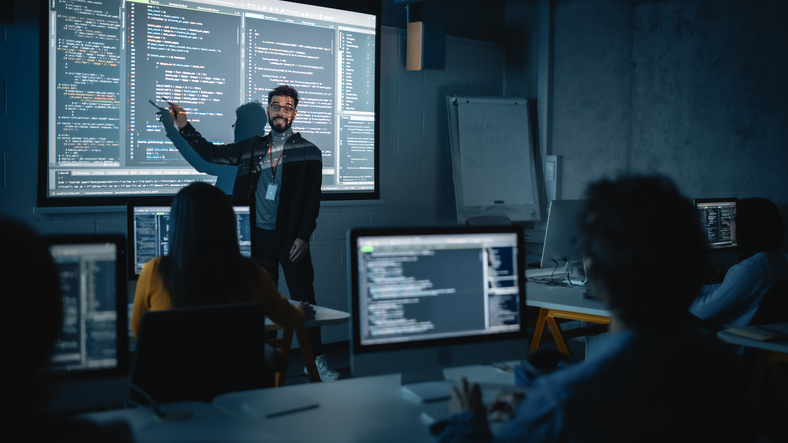As the leaves start to change and the air becomes crisp, the tech world is also undergoing a transformation with the emergence of new and exciting trends. Fall 2023 promises to be a season of innovation, bringing a range of cutting-edge tech trends that will shape the future. Here we will explore several of the most significant technology trends that have the potential to change how we work and live. These include AI, 5G and smart cities, Cybersecurity, immersive reality technologies, quantum and edge computing, and the most exciting new tech of the season: iPhone 15!

Beautiful. Durable. Phenomenal. That's iPhone 15!
Beautiful. Durable. Phenomenal. The iPhone 15 and iPhone 15 Pro family represent iPhone at its best with exceptional and durable materials, super high-resolution photos, and Dynamic Island.
iPhone 15 Pro Max. Forged in titanium and featuring the groundbreaking A17 Pro chip, a customizable Action button, and the most powerful iPhone camera system ever.
iPhone 15 Pro. Forged in titanium and featuring the groundbreaking A17 Pro chip, a customizable Action button, and a more versatile Pro camera system.
iPhone 15 Plus. iPhone 15 Plus brings you Dynamic Island, a 48MP Main camera, and USB-C—all in a durable color-infused glass and aluminum design.
iPhone 15. iPhone 15 brings you Dynamic Island, a 48MP Main camera, and USB-C—all in a durable color-infused glass and aluminum design.
iPhone 15 Pro is all the rage. And you can save $250 when you pair your iPhone with H2O's $60 Unlimited Monthly plan!
Unlimited XL + 20GB Hotspot, as low $54/Month. Enjoy: Unlimited High-Speed Data; Unlimited talk & text; Unlimited International Talk to 70 Countries; Unlimited International Text; $5 International Talk Credit.

Moving beyond iPhone 15, let's look at the other tech trends making forward progress this fall.
Artificial Intelligence (AI) and Machine Learning:
AI continues to make strides in various industries, from healthcare and finance to autonomous vehicles and customer service. Machine learning algorithms are becoming more advanced and accessible, leading to technological advancements and the development of innovative applications and services and while Artificial Intelligence (AI) Everywhere Artificial Intelligence (AI), has been a buzzword in the tech industry for some time, its impact and reach are set to expand even further.
5G Technology and Smart Cities
The rollout of 5G networks has been ongoing, and as coverage expands, it enables faster internet speeds and supports new technologies like augmented reality (AR), virtual reality (VR), and Internet of Things (IoT) devices. Beyond simply speeding up our devices, 5G will enable the Internet of Things (IoT) to flourish, with autonomous vehicles, connected devices, and smart cities becoming a more integral part of our lives.
Let's take a closer look at smart cities:
Smart cities are urban environments that leverage technology and using data science to enhance the efficiency, sustainability, safety, and overall quality of life for their residents. These cities use interconnected digital technologies and IoT (Internet of Things) devices to gather and analyze data, make informed decisions, and improve the delivery of public services. Here are key aspects of smart cities:
Data-Driven Decision-Making:
Smart cities rely on data collected from various sources, including sensors, cameras, and mobile devices. This data is used to gain insights into urban processes, traffic patterns, energy consumption, and more. Decision-makers use this information to optimize services and infrastructure.
Connectivity and IoT:
The IoT plays a crucial role in smart cities. Sensors and devices are embedded in various urban elements, such as traffic lights, waste bins, public transportation, and utility systems. These devices collect real-time data, allowing for better monitoring and management.
Sustainability:
Smart cities prioritize sustainability by implementing green technologies and practices. This includes energy-efficient buildings, renewable energy sources, waste reduction, and sustainable transportation options to reduce the city's environmental footprint.
Transportation:
Smart transportation systems aim to reduce traffic congestion, improve public transit, and promote alternatives like cycling and walking. Features of green technology may include smart traffic management, real-time public transportation information, and autonomous vehicles.
Infrastructure:
Smart infrastructure includes the use of emerging technology, to monitor and maintain critical systems like water supply, sewage, and electrical grids. Predictive maintenance and efficient resource allocation are key goals.
Public Services:
Smart cities focus on delivering efficient and citizen-centric public services. This may involve digital platforms for accessing government services, real-time reporting of issues like potholes or streetlights, and smart emergency response systems.
Digital Inclusion:
Efforts are made to ensure that smart city benefits are accessible to all residents, including those in underserved communities. Digital inclusion initiatives may involve providing affordable internet access and digital literacy programs.
Security and Privacy:
As smart cities collect vast amounts of data, security and privacy are paramount. Robust cybersecurity measures are essential to protect sensitive information and infrastructure from cyberattacks.
Quantum Computing:
Leaving 5G and smart cities behind, we move to another exciting trend in technology: Quantum computing. This is a field that harnesses the principles of quantum mechanics to process information in entirely new ways. Quantum computing is progressing, with companies like IBM, Google, and startups working on quantum computers. While practical quantum computing for everyday applications may still be some years away, we can ultimately expect quantum computing to become more accessible and powerful, opening up a host of new possibilities for solving complex problems that are impossible by traditional methods.
Edge Computing:
Edge computing involves processing data closer to where it's generated, reducing latency and improving real-time decision-making. This more computing power is especially important for IoT applications and autonomous systems. Edge computing enables real-time processing and analysis of data at the edge of the network, without needing to send data to the cloud for processing.
Blockchain and Cryptocurrency:
Blockchain technology continues to evolve, with various use cases beyond cryptocurrencies, such as supply chain management, digital identity verification, and more.
Remote Work and Collaboration Tools:
The COVID-19 pandemic accelerated the adoption of remote work and collaboration tools. Even as the situation improves, many companies are maintaining flexible work arrangements, making remote work technologies important.
Health Tech:

Digital health solutions, telemedicine, wearable health devices, and health data analytics have seen significant growth, driven in part by the pandemic.
Sustainability Tech:
There's a growing emphasis on sustainable data driven technology and solutions, from renewable energy sources to energy-efficient devices and data center operations.
Autonomous Vehicles and Mobility:
Self-driving cars and other autonomous vehicles are still in development, but they continue to be a major tech trend with potential for significant impact on global spending on transportation.

Biotechnology:
Advances in biotechnology, including CRISPR gene editing and mRNA vaccine technology, have the potential to revolutionize healthcare and other fields.
Robotics and Automation:
Robotics and automation are the new technology trends, increasingly being used in manufacturing, logistics, and various industries to improve efficiency and reduce costs.
Extended Reality (XR) Enhancements:
Extended Reality, trending technology, encompassing Virtual Reality (VR), Augmented Reality (AR), and Mixed Reality (MR), continues to push boundaries. In fall 2023, we anticipate Extended Reality technologies becoming more immersive and versatile. VR experiences will become more lifelike, making them ideal for training simulations, entertainment, and even remote work.

Cybersecurity:
As technology becomes more integrated into our lives, the need for robust cybersecurity solutions grows. This includes advancements in encryption, threat detection, and privacy protection. With digital conviction, people believe that technology can create a secure, safe and reliable digital world and help companies invent and innovate without worrying about securing the public's confidence digital trust. Therefore, it is likely that the demand for cybersecurity professionals and services will continue to increase in 2023.
Cybersecurity is a critical field focused on protecting computer systems, networks, and data from unauthorized access, cyberattacks, and damage. As technology continues to advance and become more integrated into our lives, the importance of cybersecurity cannot be overstated.
Following are some key aspects and concepts related to cybersecurity:
Threat Landscape: The cybersecurity landscape is constantly evolving, with new threats emerging regularly. Common threats include malware (such as viruses, ransomware, and Trojans), phishing attacks, denial of service (DoS) attacks, and data breaches.
Cybersecurity Measures: To defend against cyber threats, organizations and individuals implement various cybersecurity measures, including firewalls, antivirus software, intrusion detection systems, and encryption.
Authentication and Access Control: Authentication ensures that users are who they claim to be, typically through passwords, biometrics (fingerprint or facial recognition), or multi-factor authentication (MFA). Access control mechanisms limit what users can do once authenticated.
Encryption: Encryption is the process of converting data into a code to prevent unauthorized access. It's crucial for securing data during transmission and storage.
Security Policies: Organizations establish cybersecurity policies to define rules and procedures for safeguarding information. These policies cover areas like data classification, acceptable use, and incident response.
Incident Response: Preparing for and responding to cybersecurity incidents is crucial. Incident response plans outline steps to follow when a security breach occurs, aiming to minimize damage and restore normal operations.
Vulnerability Assessment: Regular vulnerability assessments and penetration testing help organizations identify and address weaknesses in their systems before attackers can exploit them.
Security Awareness Training: Employees are often the weakest link in an organization's cybersecurity. Training and education programs help raise awareness about potential threats and how to avoid them.
Cloud Security: With the increasing adoption of cloud computing services, securing data and applications in the cloud is paramount. Cloud providers offer various security features, but customers also bear responsibility for their data's security.
IoT Security: The Internet of Things (IoT) involves connecting everyday objects to the internet. IoT security is essential to prevent vulnerabilities in connected devices from being exploited.
Zero Trust Security: The Zero Trust model assumes that no one, whether inside or outside the organization, can be trusted by default. Access to resources is restricted and verified continuously.
Regulations and Compliance: Many industries have specific regulations and compliance requirements related to cybersecurity. For example, GDPR in Europe and HIPAA in the healthcare sector impose strict data protection requirements.
Cyber Threat Intelligence: This involves collecting and analyzing information about current and potential cyber threats. It helps organizations stay ahead of emerging threats and make informed security decisions.
Cyber Insurance: Cyber insurance policies can help organizations mitigate the financial impact of a cyberattack by covering costs related to data breaches, legal fees, and more.
Ethical Hacking: Ethical hackers, also known as penetration testers or white hat hackers, are security experts who actively test an organization's systems to identify vulnerabilities and weaknesses before malicious hackers can exploit them.
Cybersecurity Workforce: The demand for cybersecurity professionals is growing rapidly. Cybersecurity experts are responsible for protecting organizations from cyber threats, investigating incidents, and implementing security measures.
Tech & Employment

With AI spreading its usage in various fields, we can expect new jobs in programming, development, testing, and many more. AI also offers handsome salaries ranging from $115,000 for entry-level positions to $205,000 for experienced professionals - making it the top technology trend you must check out. It is estimated that 5G will revolutionize the way we live and work in the future.
What does this mean for you? It means you should stay current with emerging technologies and latest technology trends. And it means keeping your eyes on the digital future to know which skills you'll need to know to secure a safe job tomorrow and even learn how to get there.
As we said, fall 2023 promises to be a season of innovation. Get what might be the most exciting innovation of all - iPhone 15 - from H2O and save!
Stay abreast of every emerging tech trend with H2O Wireless where you can get iPhone 15 for less and pay just $20 a month for unlimited talk & text, 3GB data, and 2GB hotspot!






